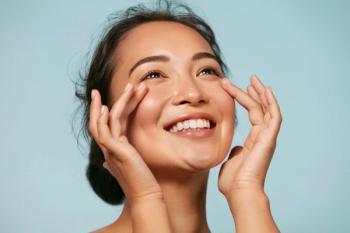
The New Face of Cosmeceuticals
In 2006, the Beauty from Within concept bloomed. This year, as manufacturers ready the next wave of cosmeceuticals, some of the newest products combine oral approaches to skin care with topical items, such as lotions and creams, for an added synergistic effect. Many of the newest cosmeceuticals are actually based on ingredients with a long history of use in other applications, making them familiar to manufacturers and consumers alike.
In 2006, the Beauty from Within concept bloomed. This year, as manufacturers ready the next wave of cosmeceuticals, some of the newest products combine oral approaches to skin care with topical items, such as lotions and creams, for an added synergistic effect. Many of the newest cosmeceuticals are actually based on ingredients with a long history of use in other applications, making them familiar to manufacturers and consumers alike.
BIOCELL COLLAGEN II CG
One well-known ingredient making the jump to the topical format is BioCell Collagen II. In May, BioCell Technology LLC (Newport Beach, CA) introduced a cosmetic-grade version of its existing BioCell Collagen II formula called BioCell Collagen II CG. The new formula contains hydrolyzed collagen peptides, chondroitin sulfate, and hyaluronic acid (HA) in a phospholipid matrix.
“BioCell Collagen II CG was developed specifically to possess properties that are essential for the care and protection of skin and hair topically,” says Suhail Ishaq, vice president of BioCell Technology. “The phospholipids aid the emulsification compatibility of BioCell Collagen II in various topical formulations and at the same time reduce transepidermal water loss, thus imparting a strong moisturizing effect.”
BioCell sources its ingredient from type II collagen extracted from chicken sternums. According to Ishaq, most of the other forms of collagen available in the market are either undenatured or hydrolyzed, and are derived from porcine and bovine sources.
“These sources usually are not as controlled as well, and contain a mixture of different types of collagen,” Ishaq says. “Undenatured or whole collagens are insoluble and do not function well in cosmetic matrices. BioCell Collagen II CG, on the other hand, has a high propensity to binding moisture with film-forming properties, contributing to skin smoothness and elasticity. The protective function of hydrolyzed collagen is particularly important to topical products where moisturizing and skin-soothing properties are desired.”
Ishaq adds that a study sponsored by BioCell showed that the ingredient can suppress hyaluronidase, an enzyme that may contribute to skin aging by accelerating the degradation of HA.
“Our expertise in the field of collagen has led to our BioCell Collagen II being the first hydrolyzed collagen and HA ingredient to be studied for oral availability,” Ishaq says. “With the introduction of patented BioCell Collagen II CG into the market, cosmetic manufacturers may expand their product line or existing formulas to include BioCell Collagen II in their topical formulations.”
FLORAGLO LUTEIN
Kemin Health LC’s (Des Moines, IA) FloraGlo lutein, already a popular ingredient in eye-health formulas, is another well-known product that may soon play a larger role in oral and topical cosmeceutical formulas. In the April 19 issue of the medical journal Skin Pharmacology and Physiology, University of Naples professor Pierfrancesco Morganti, PhD, reported that combined topical and oral administration of lutein and zeaxanthin protects human skin against UV wavelengths of sunlight. Morganti presented the results of the study at SupplySide East in May.
Pearlcaps Provide New Color Options for Skincare Products
Cosmeceutical manufacturers may be trying to emphasize the “Beauty from Within” concept, but that doesn’t mean packaging isn’t important. Pearlcaps, a new pearlescent two-piece capsule from Capsugel (Greenwood, SC), aims to give beauty products an edge by adding a touch of high-end gloss.
Pearlcaps achieve their pearled effect via the addition of Candurin, a mica-based light-reflecting pigment. When used alone, Candurin appears pearl white. However, when combined with other colors, the pigment can turn pink, green, turquoise, purple, powder blue, orange, or charcoal, and can even replicate metallic colors such as bronze, silver, and gold.
“In addition to offering new color possibilities, this aesthetic and eye-catching pearled effect can add sophistication to products,” says Bob Whitelaw, Capsugel’s director of marketing, sales, and business development. “It helps to make visually bland formulations more attractive. The use of shiny or metallic colors can fashion distinctive looks to differentiate brands.”
In the 12-week study, Morganti’s team recruited 40 women, who each received one of four treatments: oral capsules and topical creams containing FloraGlo lutein, oral capsules containing FloraGlo and placebo creams, placebo capsules and creams containing FloraGlo lutein, or placebo capsules and creams. The team then exposed the volunteers to UV radiation and measured several skin physiology parameters, including surface lipids, hydration, photoprotective activity, skin elasticity, and skin lipid peroxidation.
The team found that while separate oral or topical administration protected skin from UV-induced damage, combined topical and oral administration worked better than either method alone. According to Morganti, the topical lutein travels to the lipid lamellae of the stratum corneum, protecting them from UV exposure. In addition, the oral lutein reaches living epidermal cells through the blood serum, reinforcing the topical lutein’s effects.
“Lutein’s ability to absorb or filter blue wavelengths of light from the visible light spectrum, combined with its antioxidant properties, makes it a unique molecule,” says Craig Maltby, product manager at Kemin Health. “This dual function appears to work well for eye health, and the science is now suggesting those same qualities may impact skin as well. Blue light penetrates the inner layers of skin, and lutein is deposited throughout the entire depth of the skin as well, so its presence goes beyond the outer epidermis layer, where sunscreens are applied.”
Maltby notes that Kemin, which gave away more than 200 skin packs containing prototypes of an oral and topical combination based on the ingredients used in the Skin Pharmacology and Physiology study at SupplySide East, has received a favorable response so far.
“We’ve certainly been highlighting for customers the new research with FloraGlo lutein, and we have also been emphasizing the fact that this is a new health platform for an existing ingredient brand that’s been proven safe and effective, and comes with a 10-year established quality record,” Maltby says. “It’s an additional positioning opportunity for customers already using FloraGlo for eye-health products, and also a new product opportunity for those who have traditionally specialized in skin health oral supplements and are looking for a new ingredient concept for the cosmeceutical market.”
Maltby adds that FloraGlo happens to be a mainstream ingredient already in wide use globally. “We believe that demonstrating the science behind FloraGlo as a new skin care oral product offers great potential for supplement brands,” he says. “The Morganti study is the latest in what we have counted as more than 30 peer-reviewed, published studies in existence on carotenoids and skin.”
FUNCTIONAL KERATIN
Another company developing oral and topical cosmeceutical combinations is Keratec (Christchurch, New Zealand), which launched its new Functional Keratin line at this year’s In Cosmetics show, held April 17–19 in Paris. Keratec manufactures the products using proprietary extraction technology that solubilizes keratin proteins into a digestible form and leaves their natural amino acid structure intact.
The Functional Keratin line includes a topical ingredient, Cynergy TK, and an oral ingredient, Cynergy NK. Cynergy TK is available in aqueous solution, while Cynergy NK comes in aqueous and powdered form. In April, the entire range of materials was approved as halal for the global market.
Perspectives Publication Describes Recent Aloe Research
A new book that describes the latest research findings on aloe may boost interest in the venerable plant. Based on data collected by the South Korean Creation of Aloe Pharmaceuticals (CAP) Project, New Perspectives on Aloe covers studies dealing with a wide range of applications, such as histamine inhibition, immune stimulation, skin whitening, and protection against nephrotoxicity.
“In isolating the activities of Aloe vera, they made an incredible leap in building the scientific foundation for aloe product development,” says Ken Jones, chief science officer of Aloecorp (Lacey, WA), which provided funding for the CAP project.
For more information about the book, contact Aloecorp by sending e-mail to info@aloecorp.com or calling 800/458-2563.
According to Keratec, Cynergy may have several positive effects on skin appearance, repealing the effects of aging skin and protecting skin against future damage. The topical ingredient helps bind moisture, while the oral ingredient blocks PGE2 production, a biological pathway leading to inflammation and redness. In addition, zinc and copper protein complexes in both ingredients help repair and maintain skin.
Keratec, which uses a special process to extract the keratin from wool, claims that other keratin extraction methods cause the proteins to lose their natural functionality. On February 16, the company announced that it received a U.S. patent for its manufacturing process.
“Having our manufacturing processes fully protected is an important part of advancing closer to market with several ranges of Functional Keratin products and technologies in the United States,” says Bruce Foulds, Keratec’s CEO.
PRAVENTIN
One of the first cosmeceutical products targeted to teenagers, DMV International’s (Delhi, NY) lactoferrin-rich Praventin probably won’t make their high school years any easier-but it may improve their social lives. While lactoferrin’s role in promoting healthy skin is unclear, DMV says it may inhibit the growth of the acne-causing bacteria Propionibacterium acnes and calm the effects of inflamed skin.
According to Angela Walter, market development manager for DMV International, two DMV-sponsored studies conducted in Delhi, NY, and another independent study conducted in New Delhi, India, showed that Praventin improves skin appearance by diminishing blemishes. Another pilot study involving 10 healthy volunteers demonstrated that the ingredient also prevented cutaneous lipid peroxidation caused by the oxidation of squalene. Praventin requires a relatively low dose, which makes it a cost-effective ingredient.
“The initial launch of this product focused on teenagers, because if you look at the teenage consumer, no company has really targeted them for dietary supplements,” Walter says. “But adult females are also getting acne, and it happens to men too.”
In the first study, DMV gave 200 mg per day of Praventin in chewable tablets to 48 high school students for 12 weeks and found a 95% reduction in their blemishes over an 8-week period. After the students stopped taking the supplements following week 8, their blemishes began to return. By the end of the study, more than 75% of the volunteers said they thought their skin had improved, and more than 90% said they would recommend Praventin to a friend.
The second study involved 28 teenagers, who received either 25 mg or 200 mg of Praventin per day for 8 weeks; only the 200-mg group experienced a beneficial effect from the supplement. In the Indian study, which involved only 14 participants, volunteers took 200 mg of Praventin for 12 weeks and saw a 76% reduction in blemishes by week 12.
Walter notes that while there are some effective pharmaceutical solutions for acne, they often come with side effects. “On the topical side, you have the dryness, the itchiness, and the rashes that come along with their use,” she says. “With this product, the teens didn’t see any side effects, and their faces stayed moist and didn’t dry out. We’ve also seen repeat purchases from companies that have launched products with Praventin, which means consumers are continuing to purchase the product.”
AN $8-BILLION MARKET
Driven by a desire to look and feel young, consumers are expressing a strong thirst for natural beauty products. According to an April report from Datamonitor (London), demand for cosmeceuticals in Europe and the United States currently exceeds $8 billion. Healthcare practitioners and manufacturers are already taking action.
“Medical dermatology spas have burst onto the scene in the past three years and are helping to shape the trend for advanced, holistic skin care,” says Kemin’s Maltby. “We think the future for skin care and nutrition is healthy.”
Newsletter
From ingredient science to consumer trends, get the intel you need to stay competitive in the nutrition space—subscribe now to Nutritional Outlook.





